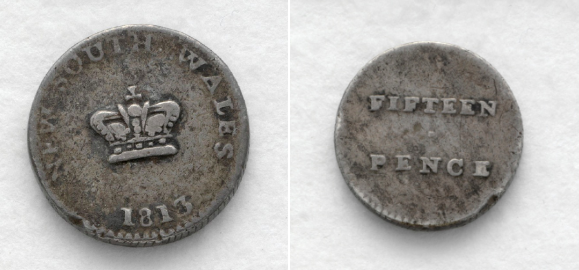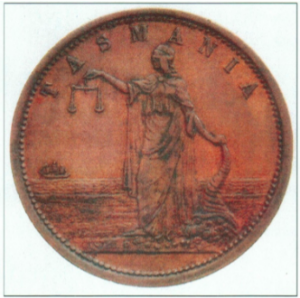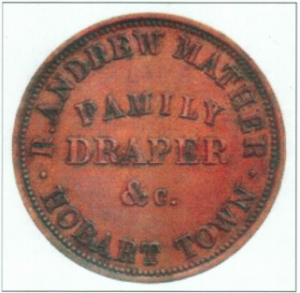
Coins are very much part of our lives, and are used to transfer value when we purchase goods, or make a donation, meet car parking fees and with small coins sometimes being used as screw drivers, amongst other uses.
We think of coins as being of either gold, silver or copper.
When Australia was settled in 1788 no official currency was established, although some coin had arrived here brought by settlers and carried aboard ships. These coins were from several different countries and in various denominations. In order to bring some order and stability to currencies in use, Governor Philip Gidley King, in November 1800 decreed that the following coins were legal tender and set their values as follows-
- Guinea = £1.1s (One pound and one shilling sterling)
- Gold Mohur = £1.17.6
- Spanish Dollar = 5 shillings
- Ducat = 9/6 (Nine shillings and six pence sterling)
- Rupee = 2/6
- Pagoda = 8/-
- Dutch Guilder = 2/-
- English shilling = 1/1
- Copper coin of 1 oz. = 2 pence
The settlers did have some George 111 one-penny coins which were referred to as “Cartwheel pennies”. These were the first British coins to be officially exported to the Australian Colonies. They were dated 1797 and 1799, with Britannia on one side and George 111 on the other. American dollars were also traded.

A shortage of coin continued, made worse by the use of coin in purchasing goods from visiting ships, thus taking coins out of the Colonies. In effort to redress this problem in 1813 Governor Macquarie imported 40,000 Spanish dollars at a cost of 4/9 each, and put convicted coin forger William Henshall to work punching the middle out of each coin, making two new local coins: the dump (the piece that was removed from the centre) and the holey dollar (the ring shaped outer piece). The holey dollar was given a value of 5 shillings, with the centre ring counter stamped New South Wales with date of 1813. The dump was made smooth on both sides with one side stamped in the centre with a crown and the rim stating “New South Wales – 1813”while the reverse was struck showing its value, “FIFTEEN PENCE”.

Holy Dollar Side A 
Holy Dollar Side B
In 1825 the British Government passed the Sterling Silver Currency Act, making the British pound the only legal currency in Australian Colonies. £30,000 in English coins was imported. This was not enough to go around, and many people still used other forms of currency to get by.

In that same year the Treasury Chambers directed, that, in the event of there not being sufficient British silver in the chest, the troops shall be paid in Spanish dollars using a rate of 52d. each, which is the nearest value as compared to British standard silver, at 5s.2d. an ounce; and other coins are to be issued at a proportionate rate with reference to their actual content in pure silver, viz
- the Spanish and East Indian dollars, which weigh 416 grains, are to be issued at 4s.4d.
- the French 5 franc piece at 4s.
- the Sicilian dollar, or Scudo, at 4s.1d.
- the Calcutta rupee at 2s.1d.
- the Bombay, or Surat rupee at 1s.11d.
Gradually, with increasing volumes of British currency being received, foreign currencies were phased out, however with the onset of the gold rush in the 1850s, coin shortages again developed. With gold becoming available in Australia, attention was given to use it for trading. In South Australia the Adelaide Assay Office opened in 1852 and bought gold from people, turning it into ingots which were stamped with their weight and purity. Ingots were then given to banks, which could release notes to the value of the gold. Later in the year, the Assay Office made £1 tokens. The Office could not keep up with the demand; it was not legally sanctioned, and it was closed down on 17 February 1853.
Merchants found the lack of small change particularly difficult for their operations and a number resorted to minting their own currency, usually of a one penny value. In 1855, Hobart clothing merchant, R. Andrew Mather had a consignment of tokens minted in England by Heaton and Sons of Birmingham, followed by a further three consignments. Other Hobart merchants issuing tokens were, R.S. Waterhouse. Alfred Nicholas and O.H. Hedberg.

R. Andrew Mather 1 Penny Token 
Family Name & Location
A mint was opened in Sydney 1855 and operated as a branch of the Royal Mint in London, the mint produced gold coins known as sovereigns. It closed in 1926. One sovereign was equivalent to £1.
Seventeen years later in 1872, the Melbourne Mint was opened, also operating as a branch of the Royal Mint in London. It closed in 1972.
Then in 1899 the Perth Mint was opened, initially operating also as a branch of the Royal Mint in London, but later wholly owned by the Western Australian government.
On 1 January 1901 the Australian Colonies came together as a Federation, and the need for a national currency was promptly raised. A committee came together to consider and eventually recommended a single Australian currency on a decimal basis. However the Government was not keen to adopt decimal currency unless Britain did the same and decided to continue the British system of pounds, shilling and pence under the name of Commonwealth of Australia.
In 1910 Australian national coins were first struck, initially silver coins of florin (two shillings), one shilling, sixpence and threepence. In 1911 the minting of copper coins commenced, pennies and half-pennies.
Gold coins of sovereigns continued to be minted but were identical to British sovereigns, only identifiable as Australian by mint mark
The only addition to the above was the five shilling Crown coin minted in 1937 and 1938 but was not popular.
All these coins remained as currency until the advent of decimal currency in 1966.
At times some coins were minted overseas, with locality being identified by their Mint Mark, for silver coins, “H” for Birmingham, “D” Denver USA., “S” San Francisco, with some pennies at Bombay India, with the mark being a “1” below the King’s head and wider denticles around the rim. Pennies were produce at both the Melbourne and Perth mints, with the Perth minted coins recording a dot after the word penny.
Between 1910 and 1966 some changes in the metal composition of coins and design occurred. Initially silver coins were made up of 92.5% silver and 7.5% copper but was changed in 1946 to 50% silver, 40% copper, 5% nickel and 5% zinc. The purpose of the change was to extract the silver from the coins to help pay off war loan debts. Consequently most of the pre 1946 coins were withdrawn from circulation and melted down.

With the change of monarchs, those of King George V, King George V1 and Queen Elizabeth 11, the front of all coins were changed to reflect the reigning monarch of the time.
In 1937 the reverse of the threepence was changed from the Australian coat of arms to show three stalks of wheat and in the following year the reverse of the penny was changed to feature a kangaroo. The halfpenny reverse was changed in 1939 to also depict a kangaroo but facing the opposite direction to the kangaroo on the penny.
Several commemorative coins were also produced.
1927 – The first, a florin marking the opening of Australia’s first Parliament House at Canberra
1951 – A florin to celebrate 50 years of Australian Federation
1954 – A florin to mark Her Majesty, Queen Elizabeth 11’s royal visit to Australia.
Decimal Currency
On the 14 February 1966 Australia converted to decimal currency. Coins issued were copper, 1 cent and 2 cent, and silver 5 cent, 10 cent, 20 cent and 50 cent pieces made at the new Canberra mint.
The silver coins, apart from the 1966 50 cent coin, were composed of an alloy known as Cupronickel, 75% copper and 25% nickel. The above 50 cent coin contained 80% silver and 20% copper but the silver content becoming worth more than the face value of the coin, production ceased. It is rumoured that many of these coins found their way to Hongkong for melting down and recovery of the profitable silver.
In 1969 a new 50 cent coin was brought out as a replacement, a 12 side cupronickel coin, which still continues in use. This same blank was used in the production of the 50 cent commemorative coins, with some 29 designs issued to date.
The one and two cent copper coins introduced in 1966 were discontinued in 1990 and withdrawn from circulation in February 1992 by which time their metal content exceeded their face value.
One and two dollar coins (of gold appearance) were introduced to replace the one and two dollar paper notes, the one dollar coin in 1984 and the two dollar coin in 1988. Both are composed of 92% copper, 6% aluminium and 2% nickel.
Compiled by Ivan Badcock in March 2017

Hello Ivan,
I seem to remember there was actually two ‘Cartwheel’ Pennies. One weighed one ounce, the other was two ounces. One valued at one penny, the other at twopence. I think that only the one penny ones came to Australia. because they are so plentiful, they are not worth a lot. I have one if you want to have a look. Good luck with this project.